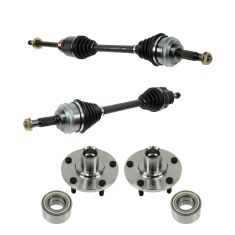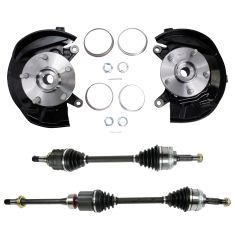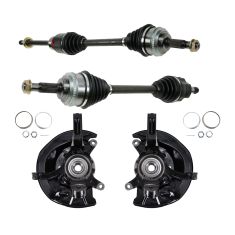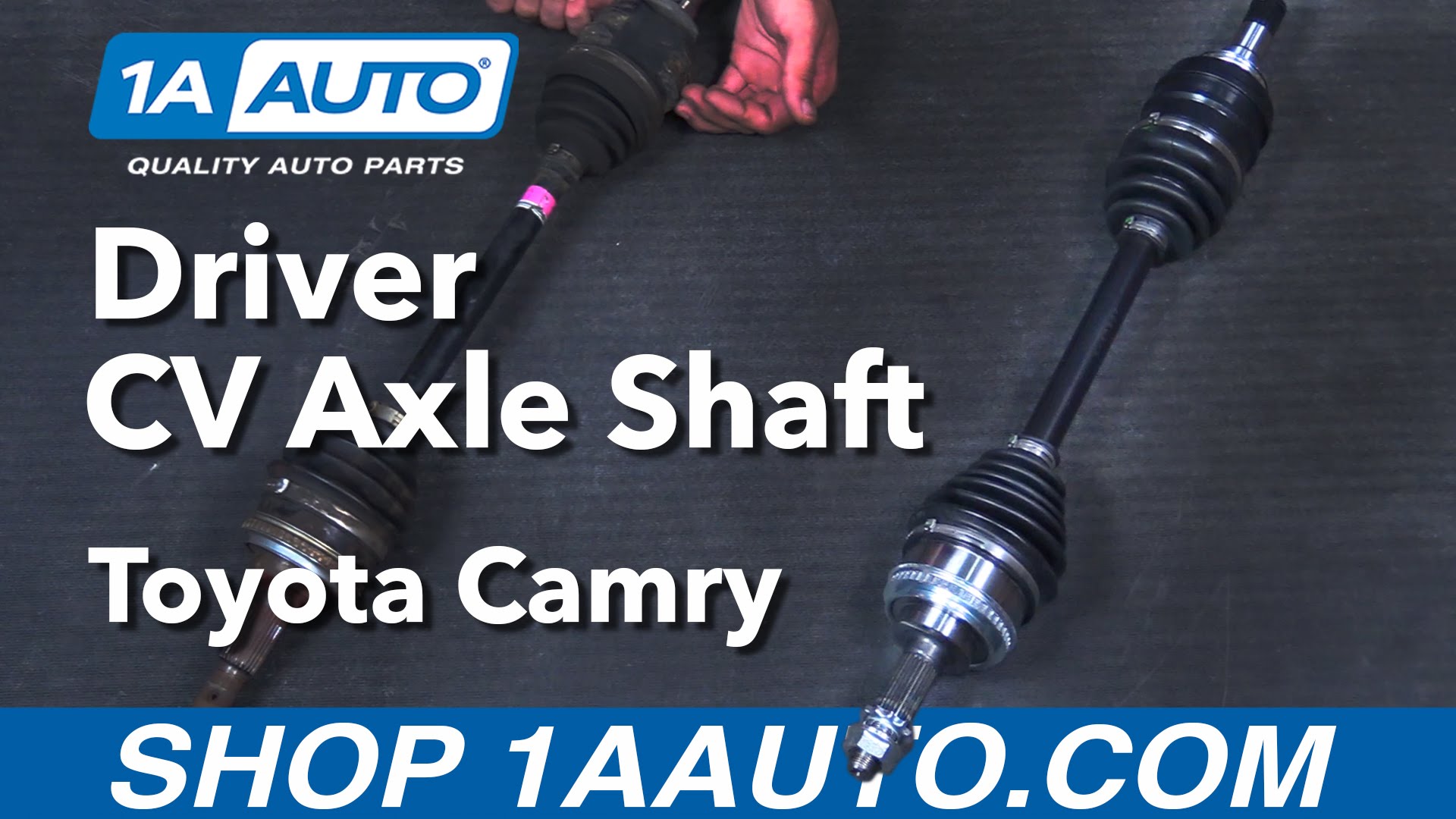1AACS00078-Toyota Camry Solara Front Driver & Passenger Side 2 Piece CV Axle Assembly Set TRQ CSA82451
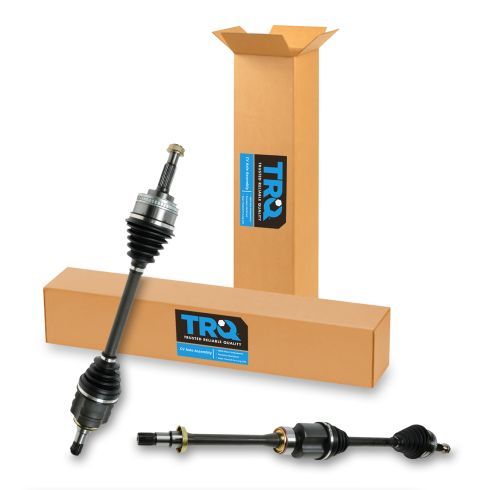


Replaces
1999 Toyota Camry L4 2.2L Front Driver & Passenger Side 2 Piece CV Axle Assembly Set TRQ CSA82451


Product Reviews
Loading reviews
4.86/ 5.0
35
35 reviews
Cv axles 95 Camry 2.2
March 4, 2017
Parts fit well, however, the input shaft dust shields were bent in shipping and they did not come with new cotter pins
best bang for your buck
August 4, 2017
product was straight forward to install, it works well, and has lifetime warranty.
But.. the only problem I had was that axle nuts provided where different sizes.
Good cv's
October 25, 2017
After a month so far so good went right on my 95 Camry
The absolute best
April 8, 2018
A friend of mines recommend this site to me and at first I'm like no way those parts are that cheap, but the kicker is they are actually brand new products for a very affordable price which is amazing. Shipping came very very fast and all my pieces were there. I would certainly give this place an A-1 rating and most certainly will be ordering again!
Best Bang for your buck
April 30, 2018
1A Auto has been my #1 choice for auto parts for my wife's 2000 Toyota Camry. Replacing these CV axels were a breeze thanks to the helpful videos and guides.
These were a direct fit and the car now has no more clicking noises when turning. Great product for a great price.
Great Price, Better Service
June 14, 2018
After reading several very positive reviews about 1A Auto, I decided to order both CV axles for my Toyota Camry from them. I was very pleased with their price, which included free ground shipping. I received my product two-days ahead of when they were scheduled to arrive. It's not easy to find a company these days who goes out of their way to take care of their customers.
I would highly recommend 1A Auto to anyone who is looking for any of the large selection of products they carry.
Perfect!
September 11, 2018
Fast shipping. Excellent quality parts. Fit my 1994 Camry perfectly. Very happy with the service and quality of 1aauto.
Best axles for the price
October 23, 2018
These axles are top quality, low priced, and are delivered super fast. Perfect fit for my 1996 Toyota Camry station wagon. The removal and replacement video helped out a ton too. Definitely recommend these parts to anyone looking to fix up their rides.
Love this place
January 2, 2019
Found parts online. I called to make a purchase the wait time was short. The customer service was great very friendly and polite, helped me find exactly what I needed and helped me get the best price. Will order from them again!
Cv axle in many more parts
January 6, 2019
Your product are very good in realiable I love be your costumer you GUYS are very good I not a mechanic but your videos are very helpful thack you for old your help
Perfect fit!
June 21, 2019
The part was an exact match to the original. Was easy to install and have had no issues since.
1994 toyota camry CV Axle shaft pair
September 7, 2019
I got the Axle on time and replaced on my vehicle with any issues and it was cheap. Vehicle runs great and I would recommend other customers' buying this part.
Review
September 27, 2019
Good parts, speedy service
1997 Camry CV axle pair
October 25, 2019
When i was planning to replace my very bad, noisy driving axles, i did some research for a DIY attempt. I watched several videos online, but the most helpful and best video "How-to" was from 1A Auto.
So i was like, if the best video is from 1A Auto, then i should buy from them. I ordered. It was delivered. I installed the two axles.
Perfect fit. The car runs great!!!
Good Axle
November 6, 2019
Exact fit, But there was trouble in removing existing axle as the car is 20 Years old so I would recommend buying CV Axle Shaft Popper Tool along with the Axles as it seems that with that tool the efforts would be lessen.
January 13, 2020
Yes the parts is just fine .
Works great
February 3, 2020
Had a question to see if it was the right fit, had avs grooves, so I called, they said yes and wouldnt you know it. They were right! Great product
Great Product
May 3, 2020
I highly recommend purchasing these axel shafts if you need to. Theyre superb quality and delivery was fast. Replacing the old axel shafts in my car made a huge difference as the sound is gone and it drives smooth like a dream.
97 Camry axles
March 26, 2021
Nice looking piece , fit perfectly & great prices, would definitely purchase again
Smooth driving
April 9, 2021
Man these parts are the truth, it was kinda hard getting my old ones off cause they havent been changed but eventually I took them off and man was it easy to install the new ones, just a few taps in and BAM its in there now my Camry rides like a beauty.
Great parts and videos
May 18, 2021
I absolutely recommend these axle shafts. The parts were nicer quality than stock and way less expensive than oem replacements. The boots are thicker than stock, the shafts themselves are thicker than stock. And the videos answered any questions I had during install.
Awesome
October 26, 2021
Great product and Exact fit! Thanks 1A Auto
CV JOINT FOR 1999 CAMRY
October 27, 2021
Passenger side CV joint had been damaged slightly. 1a auto promptly replaced it. Driver's side fit perfectly! Good product, great fit and excellent professional service.
Great Product
November 8, 2021
Quick shipment but one axle was missing. It looked like it was mishandled during shipment. A quick call and a replacement axle was on it's way. Great customer service.
November 21, 2021
Working good
Works well
May 11, 2022
Works good
2000 toyota camry
May 20, 2022
Product fit as advertised and works well.
November 6, 2022
car broke 4v days after installation haven't drive since
February 17, 2023
Toyota Camry not solera I hope you guys sent the right one.
Perfect Match
July 12, 2023
Great parts as always
Easy install.
October 14, 2023
The axels I received from 1A-AUTO fit perfectly, installation was a breeze. I also installed axel seals while I had the chance. No more clicking when I back out from my parking place at work.
Great axle assembly
November 25, 2023
Installed these years ago, still in perfect shape, no rust, no rubber rot, no wear slop, exact OEM replacement.
Thank you 1AAuto!
Great product
March 25, 2024
Product came as described. Quick shipping easy install would recommend this company.
May 6, 2024
Work perfectly fine ordering and shipping was very much pleasing I love ordering from this site keep up the good work I'll recommend this to everyone
November 23, 2024
This is actually better than the locally available versions,
Customer Q&A
Brand name of part I'm ordering?
April 23, 2016
10
We have a few different aftermarket companies build these parts specifically for us, as our 1A Auto house brand. They are manufactured to the same OEM specifications as the original part that came with your vehicle and are covered by a lifetime warranty. If you have any further questions, please don't hesitate to ask.
April 25, 2016
Brian F
Toyota is a registered trademark of Toyota Motor Corporation. 1A Auto is not affiliated with or sponsored by Toyota or Toyota Motor Corporation.
See all trademarks.









